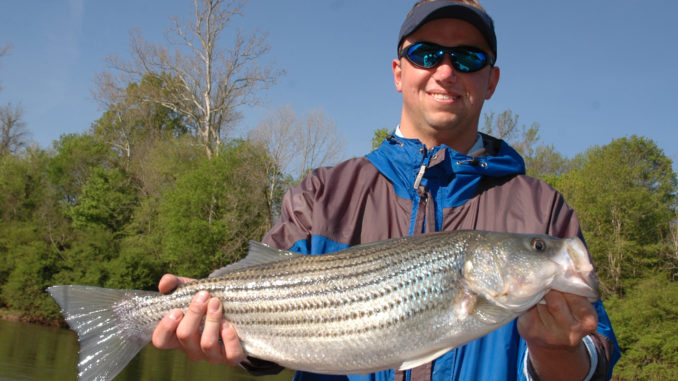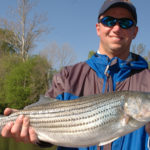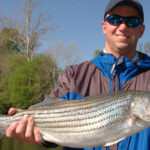
Cold weather can provide new tests for anglers
If you’re getting tired of sitting in your deer stand or bored with football games on television, I think I might have a little something that will make your December more fun.
This is a great month to target a couple of fish that are among the best-tasting of anything in freshwater: striped bass and walleye. Most of the lakes in the Carolinas have striped bass, and a few of them have walleye: Lake Hartwell in South Carolina, a lot of North Carolina’s mountain lakes, plus Lake Gaston and Buggs Island on the Virginia border.
Those are the two closest to me, and I’ll pack up and make the drive up there for some fishing that’s different from what I do most of the year — but no less fun. And giving you something to do in December is a plus.
December and January are our best months to target stripers and walleye, because they’re more active in cold weather than most of our warm-water species. You can catch a few in November, and they’ll bite through February until the water starts warming up, but December and January are tops.
What I do is fairly simple. I grab a dozen jigging spoons and a dozen bucktails, pack up a half-dozen Lew’s flipping sticks, and make sue my electronics are really sharp, because that’s all there is to it.
Step one is to get out on the main-river channel. These fish are going to be somewhere in 18 to 25 feet of water. I look for them on turns in the channel, on underwater points — any sharp drop, and the sharper the better. A 10- or 15-foot drop is perfect. Old pond dams, old road beds, the ends of old ditches; that’s what I look for, and there are plenty of those in Buggs Island and Gaston. It’s just a matter of finding them; these are the places these fish come to eat.
What makes these places even better is if they’re facing the current, and if the water is moving. Fish are always going to be active early and late in the day, but if they’re moving water or if you’ve got a weather front coming in, the fishing can be good all day.
I’m going to use maps and my Raymarine electronics to find places like this, and our electronics are so advanced these days, you can see these fish stack up; that makes it easier than back when we just had old-timey flasher units. It’s hard to tell largemouth bass and walleye apart, but these units are so good that you can see stripers marking as bigger fish. You need these fish to be facing the current, and with a little bit of patience, you can catch a few; sometimes, it feels like you’ve got to hit them right on the head, but you’re fishing vertically.
I’ll start with a Hopkins 150 jigging spoon or a bucktail, and I’ll jig it vertically. It’s almost like crappie fishing straight down beside the boat or fishing a drop-shot rig for bass. I use a heavy action, 7-foot-6 Lew’s custom flipping stick, with a BB-1 reel spooled with Trilene XL. If I’m fishing for big stripers, I’ll use 17- or 20-pound test. If I’m fishing over what I think are walleye or largemouth bass, 14- or 15-pound test will work. You want the long, heavy rod because you’re having to set the hook in 20 feet of water, so the leverage you get is important. You can probably fish a 7-foot-2 rod, but I like a 7-foot-6.
The heavier line will help slow the fall of the spoon, and that can be a big plus, but really, if you get into big stripers that are turned on, you’re going to wish you had 17- or 20-pound line.
You need to have a handful of Hopkins 150 and Shorty 75 jigging spoons, some with the feathers tied into the hook, some not. Feathers give the spoon a little more zing, and I’ve had days when they made a big difference. I’ll also have several 3/4- and 1-ounce bucktails in case they won’t hit spoons.
If I’m marking stripers, I’ll jig that spoon with a sharp rip of the rod tip, jerking it up 2 or 3 feet. Stripers are usually more aggressive, and they’ll hit it like that. If you don’t get any strikes, try jerking it just a foot or 18 inches. Sometimes if you’re jigging into walleye, all you need to do is pick it up enough that the spoon will flip. Striper, walleye or largemouth bass, they’re going to usually hit it on the fall. If it’s a striper, you’ll know immediately; they’ll rip off about 40 yards of line. A walleye bite will be a little tap. You’ll think you’ve hooked a stick, but when you wind it up, you’ll feel them start pulling and swimming off.
I’ve had some awfully good days in December catching these fish. I have to admit I didn’t even know walleye were there until one day when we were at Lake Gaston, catching plenty of big stripers in the high 20-pound class, and all of the sudden, we were catching 8- and 9-pound walleye. It turns out, Virginia has a stocking program in place on Buggs Island and Gaston.
One really good thing about these fish is, if you can find them and get one of them to bite, you’ve got a good chance to catch two or three of them in that spot. So take a day, tie on a half-dozen spoons and bucktails, make the trip and see if you can tie into one of these great fish.






Be the first to comment